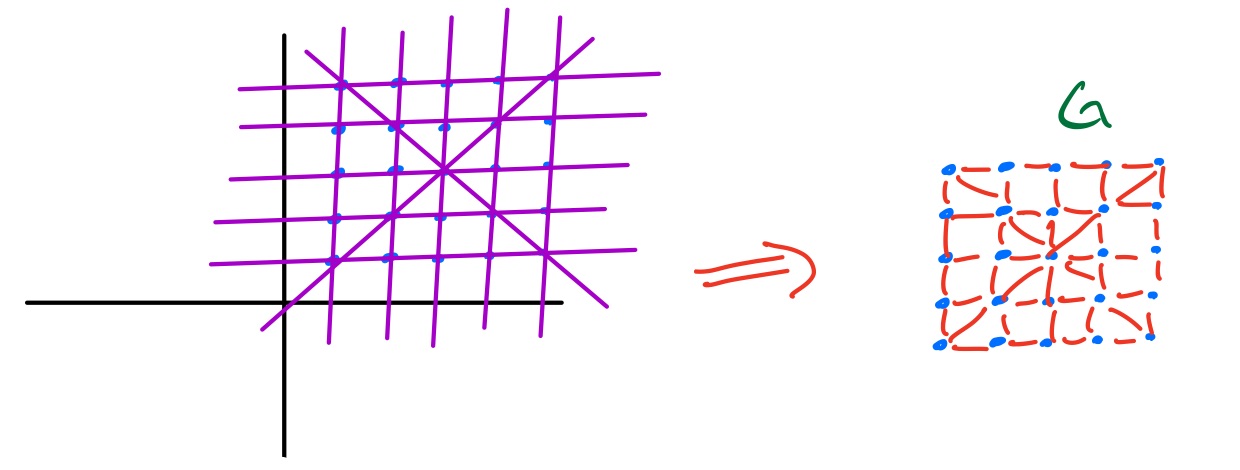In this post I am gonna talk about some (sum) super fun stuff, with very slick proofs. Let $A \subseteq \mathbb R_+$ be a set with $n$ elements. Consider the "sum set" $$A + A := \{ a+b \: : \: a, b, \in A\}$$ and the "product set" $$A \cdot A := \{ a\cdot b \: : \: a, b, \in A\},$$ which is not to be confused with the cartesian product. It is easy to note that both of these, on their own, can be small. For example, if $A = \{1,...,n\}$ (or for that matter any arithmetic progression), then we have that $|A+A| =2n-1$. However, in this case, $|A\cdot A|$ is nearly (but not quite) $n^2$. On the other hand, when $A = \{ 1 ,2 ,4, ..., 2^n\}$ (or any other geometric progression), we have that $|A \cdot A| \leq 2n-1$, but that $A+A$ has nearly $n^2$ elements. Long ago, Erdös asked if this was a general phenomenon, i.e. if it was true that in general, for all $\epsilon > 0$, we have that $$T_A := \max \{ |A + A|, |A \cdot A|\} \geq n^{2-\epsilon}.$$ We haven't quite proved this yet, but we have made some very interesting progress over the years.
Agenda
In this post I will discuss a beautiful result of Elekes, who showed that $T_A \geq \Omega(n^{5/4})$. In order to give a self contained proof, we have to discuss some other interesting results and consequences related to crossing numbers of graphs, but trust me it will be worth it!
I will not be covering what is essentially the state-of-the-art which is a lovely proof from Solymosi that $T_A \geq \tilde \Omega (n^{4/3})$. There are two reasons for this:
- Timothy Gowers already gave a great exposition of this result, and I don't want to reinvent the wheel here or even attempt to compete with Tim Gowers.
- This post would become prohibitively long (not that Solymosi's proof is long -- it isn't!).
Crossing Numbers and Consequences
Let's completely switch gears for the moment. Given a graph $G$ with $n$ vertices and $m$ edges, we can attempt to draw it in the plane. The crossing number is the minimum number of times we must "cross" edges in order to do so. We say that a graph is "planar" if its crossing number is zero! (One of) Euler's Theorem(s) gives a famous way of relating the number of edges, faces, and vertices if the graph is planar:

Ok, now lets get to some less TCS 101 intro stuff. What can we say in general about larger $m$? For the sake of not letting the length of this post get too out of hand, I'll just get right to it. Here's the lovely theorem.
First, we claim that $cr(G) \geq m - 3n + 6$. We can prove this via induction on $m$. If $m \leq 3n-6$ then the bound holds trivially. If $m > 3n-6$ then via the above corollary there must be at least one crossing. Delete one of the edges involved in this crossing, leaving a graph with $m-1$ edges. By the induction hypothesis, this graph has $m - 1 - 3n + 6$ crossings, establishing what we want.
Ok, now we claim that $cr(G) \geq \frac{1}{125} \frac{m^3}{n^2}$. This time, we shall induct on $n$. Note that, since $m \leq n(n-1)/2$, the first time it is possible for $m \geq 4n$ is when $n =9$, and in this case it must be that $m=36$ (i.e. we have a complete graph). In this case, a calculation shows that $cr(G) \geq m -3n + 6 =15 \geq \frac{36^3}{125\cdot 9^2}$. Alright then, that settles the base case. From now on $n \geq 10$.
- Case 1: Suppose $4n \leq m \leq 5n$. In this case, we have that $$\frac{m^3}{125\cdot n^2} \leq n \leq m - 3n + 6 \leq cr(G),$$ so we are done.
- Case 2: Now suppose $m > 5n$. Consider a single crossing $c$, which involves two edges. Now consider removing a vertex $v$ from the graph. The crossing $c$ remains in the subgraph $G-v$ (which is just $G$ without vertex $v$) iff $v$ was not involved in the crossing. Therefore, we can "overcount" each crossing $c$ at most $n-4$ times. Thus, $$cr(G) \geq \frac{1}{n-4}\sum_v cr(G - v).$$ We let $m_v$ denote the number of edges in $G-v$. Note then that $\sum_v m_v = (n-2) m$. Via Jensen's inequality, we also have that $$\sum_v m_v^3 = n \mathbb E [m_v^3] \geq n \mathbb E [m_v]^3 = n (m(n-2)/n)^3.$$ With this in mind and the fact that $m_v \geq 4(n-1)$, we can apply the induction hypothesis to $G-v$: \[ \begin{align*} cr(G) &\geq \frac{1}{n-4}\sum_v cr(G - v) \\ &\geq \frac{1}{n-4} \frac{1}{125\cdot (n-1)^2}\sum_v m_v^3 \\ &\geq \frac{1}{125}\frac{m^3 (n-2)^3}{n^2(n-1)^2 (n-4)} \end{align*} \] To finish the argument, it suffices to note that $(n-2)^3 = n^3 - 6n^2 + 12n -8$ and $(n-1)^2(n-4) = n^3 - 6n^2s + 9n - 4 \leq (n-2)^3$ for all $n \geq 10$.
This proof, while simpler to parse, is a slightly weaker than what was proved by Ajtai, Chvátal, Newborn, and Szemerédi (they get the constant $1/100$).
Using Crossing number Theorems to Achieve Ekeles' Bound
Ok, we are so close to proving Ekeles' bound! Just one more corollary!
For each $a_i, a_j \in A$, define $f_{ij}(x) = a_i(x - a_j)$. The key observation is that this function (which is notably linear), maps at least $n$ points from $A+A$ to $A\cdot A$. Indeed, plugging in $a_j + a_k$ for any $a_k$ results in $a_i\cdot a_k$. Let $P = (A + A)\times (A\cdot A)$ be our set of points, and note that $n \leq \sqrt{|P|}$. Note also that the number of lines with at least $n$ points is at least the number of functions we have defined, which is $n^2$. Then we can apply the above corollary to obtain that $$\ell = n^2 \lesssim \frac{|P|^2}{n^3}.$$ Rearranging gives $|P|^2 \geq n^5$, which implies that $T_A \geq n^{5/4}$, as desired!